Shared posts
HISTORIA DE GALICIA conferencia de Anselmo López Carreira
TERROR POP
El cuento de miedo como heterodoxia española
En agosto de 1973, el periódico La Vanguardia publicaba un artículo donde el periodista Tomás Salvador expresaba su sorpresa ante el auge del terror en España y buscaba explicación a todas esas películas que nutrían los cines de barrio mientras los monstruos invadían quioscos a través de tebeos y novelas de bolsillo. Es una de las pocas ocasiones en las que la prensa oficial se hizo eco de una manifestación cultural en apariencia subterránea. Aunque es cierto que el fenómeno era fruto de una moda global, en nuestro país resultaba anómala porque el nacionalcatolicismo había capado por vía del ordeno y mando muchas manifestaciones del horror mientras la Cultura con mayúscula despreciaba este tipo de ficciones, hasta el punto de que podemos considerar heterodoxa cualquier incursión en el género. Pese a ello, el cuento de miedo encontró un resquicio de salida a través de novelitas escritas bajo seudónimo, historietas de terror de factura industrial y películas de escaso presupuesto. Un terror sencillo y popular que Amando de Ossorio (La Coruña, 1918-Madrid, 2001) encarna a la perfección porque hunde sus raíces en el folclore y el cuento de miedo propio de la víspera de Difuntos.Seguir leyendo
Hace unos meses tuve la oportunidad de colaborar con el Instituto Cervantes con la redacción de un texto para su muy necesario y oportuno ciclo Terror Pop, dedicado al glorioso cine de terror español del tardofranquismo. Además, tuve la suerte de que me tocó escribir de una de mis películas favoritas de esa etapa: El ataque de los muertos sin ojos de Amando de Ossorio. Arriba les he dejado el inicio del artículo, que continúa aquí.
De todas formas, mejor no acudir sólo a mi texto, ya que no estaba sólo: Joan Ripollés Iranzo contextualizó el subgénero con Terror Pop, Rubén Lardín escribió sobre La marca del hombre Lobo, David Mejía sobre Drácula contra Frankenstein y Fernando Carmena sobre Pánico en el Transiberiano. Las cuatro películas, a su manera, obras maestras.
You’re Doing Kegels Wrong

The model pelvis/vagina in Julia Di Paolo's office. Photo by the author
Most people know Kegels as a lady-business exercise that women do to heal their vaginas after they’ve had a baby, or something older women try in an attempt to delay the inevitable need for diapers, or what young women do when they’re trying to keep their lower half in tiptop condition.
What you might not know is that there are levels to this shit. First, both men and women can benefit from exercising the pelvic floor (a.k.a. the area and muscle fibers covering the space underneath your pelvis). It can improve your orgasms and posture, and it doesn’t involve going to the gym (the most effective workout for your pelvic floor is sex). Still, there’s a lot of misinformation about what Kegels and pelvic-floor exercises can and cannot do.
I wanted to get down to the brass tacks of genital strength improvement, so I called registered pelvic-floor physiotherapist Julia Di Paolo—a veteran of the physiotherapy world for 17 years, four of which she spent as one of Toronto’s 54 trained pelvic-floor specialists—to learn more about preventing organs from sinking into your vagina, what you should do if you experience pain during sex, and why picking up an imaginary blueberry with your vagina may be the secret to better fuckin'.
VICE: What does a pelvic-floor physiotherapist actually do?
Julia Di Paolo: We are regular registered physiotherapists, but we have specialized education, so it’s post-grad education. We are the only ones who go internal, which means fingers into the vagina or the rectum to assess the musculature of the pelvis. There’s a lot of muscles you can’t access from the outside, and some of them you can access, but not very easily. Going inside is the only way to tell if a muscle is too tight or too loose or too short.
What kind of clients do you typically see?
I see a lot of women who are pregnant or just had their babies. And then we have a subset of the mothers of the women who just had their babies, because the women I treat go home and tell grandma, who is looking after the new baby, what they did, and she says, “Well, I leak too,” and she comes to see me.
Women in menopause are at high risk because they’ve delivered babies years ago, and then they have 20 or 30 years without pelvic support, so over 50 percent of them have prolapses—that’s when the organs kind of lean down into the vagina and aren’t supported anymore.
Leaking at no point in your life is normal. The only time you’re allowed to leak is the first week or two to about six weeks, postnatally. The patients I see will be like, “Well, I told my doctor, and he said at six months come back if it’s still leaking.” Well, would you let someone else go around with six months of pain for nothing? No. And it’s a muscle injury that’s really easy to cure. Four to six visits and it’s cured.
Do you see any younger clients?
The younger women we see are often pain patients. They have pain in their vulva, pain in their vagina, or pelvic-girdle pain. A lot of these women can’t have sex without pain. And it can be really debilitating—some of the women can’t even wear underwear. They walk down the street and get a shot of pain in their vagina for no reason. So they’re a whole subset group of pain, and they get bounced around from doctor to doctor. A lot of them have never had babies, so they just have this crazy pain in their vaginas, and some of them have had it since they were teenagers.
What causes this pain?
Lots of different things. A UTI can be one; a bad sexual experience can be another. Girls who have trouble with tampons seem to be at a high risk of developing pain. When there’s no trauma to the tissue and the tissue is technically healthy, we look at the nervous system to see where it’s coming from. It’s often because the message that the body gives the brain is off. The brain interprets sexual contact as pain. It feels like daggers being stuffed in your vagina. There’s also the unprovoked type—women who just walk down the street and for no apparent reason get a shot of pain in their vagina.
If they can't wear pants or underwear, what do they do?
Skirts. They just wear skirts with thigh-highs. And hope and pray they can get through their day.
Are Kegels and pelvic-floor exercises the same thing?
Kegel is the name of the gynecologist years ago who thought, This is a muscle problem and women should be strengthening these muscles, and he’s absolutely correct. The problem is not every pelvic floor issue or pelvic-girdle problem needs Kegels.
You have two types of problems in the pelvic floor: One where the floor is too tight, and one where the floor is too lax. Postnatally, most women will need Kegels, but not all. If someone’s had a C-section and they have a really tight pelvic floor, I’m not going to give them Kegels. I teach 13 different types of Kegels. People think that’s a lot, but just think of it like this—when you go to the gym, you don’t just do bicep curls. The pelvic floor is not just one muscle; it’s a bunch of different ones. So when they squeeze, when you use the pelvic floor, you have to squeeze and lift. My favorite one is the core breath. I call it "blueberry."
Please explain.
Blueberry is when you take a big breath in and let everything release as you squeeze. After the big breath in, I tell them to exhale and pick up an imaginary blueberry with their vagina and pull it up and into their body. So there are two components: They have to squeeze, and they have to lift.
[...]
You’re trying it now, aren’t you?
[Laughs]

Julia Di Paolo. Photo via PhysioExcellenc.ca
So it’s like going to the gym for your vagina?
Yeah, but it’s not like you’re maxing out. You’re not picking up pianos with your vagina—you’re picking up blueberries, so don’t squish them and make a mess. It’s very gentle.
If you just sit and do Kegels all day, it’s only going to take you so far. If you want to run a marathon, you need to run a lot of miles. If you want to have a really good pelvic floor, then you need to engage your pelvic floor in other movement patterns as well. So I will check them in squats, in lunges, and bridges—all sorts of different exercises that are pelvic-floor-friendly so that we can get them to engage and get everything to coordinate again.
Have you heard of Pfilates—pelvic-floor Pilates? They took a bunch of exercises from Pilates and looked at the EMG testing to see which ones had the best recruitment of the pelvic floor, and they chose ten of the exercises. A few are worthwhile: bridge, clam, squat, lunge, one-leg stand, hover. It’s just integrating the pelvic floor into regular exercises, and that’s how you keep your pelvic floor healthy for life. That and having sex. Sex is the best thing for the pelvic floor. The husbands all love me for saying that.
What is it about sex that's so great for the structural integrity of our vaginas?
It’s the best thing because when you think about the penis going into the vagina, it’s going to cause lubrication, which is super important for the vaginal walls, especially as we age and lose elasticity and estrogen and lubrication. Any muscles that are being used a lot will have good blood flow. Muscles that don't do anything get weak, atrophied, and frail.
So it increases lubrication and blood flow. And then you get contractions when you’re having sex, so you're actually using your Kegels, and often you should be using—or at least trying to use—what we call “geisha exercises”—it’s those exercises I told you about earlier, but on a penis.
Basically, you get contractions when the penis is in there, and when you hit orgasm you get more contractions and then a full relaxation. It brings you through the whole gamut. It’s the most wonderful exercise for the pelvic floor.
Is that the same for anything you put in there, or just a penis?
I wouldn’t put a cucumber in there. But yes, toys are the same. Anything that goes in that’s shaped like a penis… fingers are a little more pokey, so they don’t have quite the same effect. That’s all operator-dependent. But penises and toys are usually good. One thing I don’t like are the balls—the cones and the weights and the balls. Holding balls in the vagina is not the way the vagina works.
Can you always tell when people are doing Kegels?
I can. I watch people; it’s hilarious. I can tell—no one else will be able to tell.
Follow Devon Murphy on Twitter.
Hospital Selfies Are Therapeutic, Not Narcissistic

The wreckage of a fiery California bus crash that killed ten and injured dozens of others was still smoldering just after midnight on Friday when 17-year-old survivor Jonathan Gutierrez SnapChatted a sickbed selfie to a handful of friends. Almost immediately the photo went public, and then viral, all of which—predictably—ignited a shitstorm around the internet.
“Like the Funeral Selfiebefore it, the Hospital Selfie exposes a massive generational divide about the etiquette of self-expression and oversharing, especially in the face of disaster,” Joe Coscarelliopined for New York magazine, while commenters called it “emotionally stunted” and “fucking stupid.”
But actually, the gravely ill and gruesomely injured post self-portraits far more graphic than Gutierrez’s all the time. Though not as popular as #yolo or #tbt, hashtags like #piccline, #dialysis, #chemo and #amputee each turn up thousands of results, most of them geotagged to hospitals and clinics. While the comparison to funeral selfies is tempting, there’s evidence to suggest something very different is happening here.
“There’s a long history of people who are sick making images of themselves to make sense of their experiences,” said Professor Susan Bell, a sociologist who teaches illness narratives at Bowdoin College and argues that trauma selfies may be more closely related to the pathology self-portraits of artists like Jo Spence or Frida Kahlo than their oversharing coevals. “I think there's something about having that image or having the object and putting it out there that confronts people, that connects and disrupts in a way that's very different than words.”
Patients who post medically explicit snaps of themselves on social media often describe Instagram as a kind of opiate, one that amputee Libby Schaffer uses to ease her phantom limb pain and brain tumor survivor Noël Day Bishoptreats like group therapy. For Alex Blaszczuk, paralyzed from the chest down in a car wreck, posting her trauma online is nothing short of an exorcism.
“The more I repeat it the less real it becomes,” the third-year Columbia University law student and Google Glass explorer said of sharing her C5 complete spinal cord injury and its aftermath on social media. “The idea of sharing trauma, at least for me, is not so much to elicit anything back but just to get it out of me.”
When she’s not in class, the 26-year-old can be found #swaggerjackingstephenhawkingon Twitter and documenting her daily life on Flickr and YouTube. Though she said her disability is always the first thing strangers see, Blaszcuk argued that narrating her new body in pictures and video and to share those reflections on social platforms helps her define herself beyond her wheelchair.
“There’s this ‘supercrip’ narrative: despite injury you are able to do everything and so much more than just the average person, so you’re no longer a person, you’re someone who did something despite or because of your injury,” Blaszcuk said. “This narrative of my mobility impairment somehow making my life a war zone is highly problematic ... I don’t assume that [peers] have a quote unquote constant struggle. I assume they’re dealing with their shit and I’m dealing with mine.”
It’s just the opposite for Day Bishop, whose epilepsy is all but invisible most of the time. Her hospital selfies are intended to call attention to the same things Blaszcuk’s self-portraits often elide. In posts that attract scores of comments on Instagram and Facebook, the focus is on the response.
“With medical stuff, people don’t know how to talk about it and don’t know how to start the conversation,” she explained. “Putting it out there [on social media] really helps. It’s really hard to, but it really helps.”
The New York-based filmmaker and actress said Instagram in particular has introduced her to an entire network of fellow patients, one she’s come to rely on for medical information and emotional support since having her tumor removed in 2012.
“When I was on Instagram, I would click on different hashtags of #brainsurgery or #craniotomy and see so many other people’s pictures of their scars. It was so cool,” Day Bishop said. “Just typing in a Google search on the Internet, that’s kind of what I was looking for. I was looking for affirmation from somebody else.”
As with Blaszcuk, whose credits Google Glass with returning her sense of aesthetic independence and facilitating previously foreclosed modes of self-expression, Day Bishop sees Instagram as intrinsic to her health and wellbeing.
“It’s the hardest thing I’ve ever done,” she confessed of her illness. “[Instagram] is such a new thing...I feel lucky that I was able to have that resource going through this.”

Schaffer, 32, also leans on social media for support, though of a slightly different shade. For her, seeing others draw strength from selfies of her stump renewed her sense of optimism in the difficult months after her left leg was amputated. She suffers from Chronic Regional Pain Syndrome, an inflammatory disorder that was set off when she broke her left heel at age six and transformed her left leg into a swollen, useless appendage that caused her constant pain. She told me that the graphic images she posts online draw much needed attention to the rare and debilitating disease that’s affected her life for nearly three decades.
“I get emails on a daily basis from people all over the world,” Schaffer said. “I’ve become an inspiration for them.”
Recently, her online presence helped her heal from another medical trauma: Since her surgery in September, Schaffer said she’s turned to Instagram to ease her “phantom limb pain,” a complex neurological phenomenon that affects up to 80 percent of amputees, creating uncomfortable sensations where the limb used to be.
“When I take pictures and I see ‘oh, I don’t have a leg,’ I recognize that I don’t have the leg, and it helps with the pain,” she said. “Having other people who’ve gone through it say, ‘You look good, you’re doing great, your leg looks healthy,’ ... you sit back and think, I lost my leg months ago, but I’m still here.”
Although she’s often the object of Internet trolls, Libby said she both functions indispensable.
“Now that my leg’s gone, I get a lot of kids going ‘mommy, she doesn’t have a leg.’ The parents overeat and say, ‘no, don’t do that.’ But I say let them do that ,,, I try to make an example of myself,” Schaffer said. “That’s a bit part of the whole sharing online … if you want to stare, at least ask somebody. Don’t make assumptions before you know anything.”
Sick people will keep posting. The volume of images and videos alone suggests that trauma selfies are no more likely to fade than Frida Kahlo’s gruesome self-portraits of sixty years ago. It’s able-bodied people who angst over public images of the infirm, dismissing them as avatars of social media’s endemic narcissism. There are more than 400,000 millennials living with disabilities in America alone, with an untold number sharing their lives on Instagram et al. To those on the other side of the lens, graphic images are a way of forcing others to confront a reality most would rather not: that while the body may break, life limps on, just as complex and human as it was before.
“They’re all constructed in one way or another,” Dr. Bell said of the images. “One of the effects of doing this is to call people out, to say ‘pay attention!’ Another is to say, ‘I’m here, where are you?’ It’s a way of forming community among fellow sufferers, which also has a long history of occurring in different forms or mediums.”
Blaszcuk the law student adopts a similarly philosophical approach to her own trauma, citing French psychoanalyst Jacques Lacan’s three orders—the imaginary, the symbolic, and the real—to explain how she internalizes a loss that was both instantaneous and unimaginable before it happened to her.
“You’re choosing to kind of say, this image or this text or this video, this is where I’m boxing in this experience,” Blaszcuk said. “Maybe not as tidy as I’d like it, but it’s a little neater, a little tidier than this monster that it is. Especially if I can make someone laugh about it, and then I laugh about it, then it’s just a huge relief.”
Our Favorite Responses From Harrison Ford’s AMA!

Harrison Ford did a Reddit AMA yesterday! Between promoting his current environmental project, Years of Living Dangerously, and answering questions about filming Indiana Jones (that we already knew the answers to), there were a few perfect gems. Just some good old Ford-ian snark that we thought you’d appreciate. Check it out:
[Fordian is a great term, really.]
On what’s beneath the floorboards of his old house:

On smart business decisions:

And on generally being a boss who wins our hearts over again and again:

We’ll be swooning. All day. He knows we love him, you guys. He knows.
The rest of the AMA can be enjoyed over here!
The better robots of our nature
Dutch teenager actually arrested for tweeting fake terrorist threat to American Airlines

As reported earlier, over the weekend, a 14-year-old tweeted a fake terrorist threat to American Airlines, and subsequently freaked out thinking that she was going to go to jail for doing something so dumb. As it turns out, that freakout may not have been entirely in vain.
The girl, identified only as Sarah, was taken into custody by Dutch Police this morning accompanied by a relative, and is scheduled to have a hearing soon, according to the Rotterdam Police’s Roland Ekkers.
Says Sarah, “I always wanted to be famous, but I meant like Demi Lovato famous, not Osama bin laden famous.” Says me, “What is a Demi Lovato?”
Was it stupid? Yes. Was it obnoxious? Obviously. Is it something she should do hard time for? I’m gonna say no. Even a fine would be ridiculous, as it would be her parents who would have to pay it. As much as it’s important to take threats seriously, it’s pretty dumb to take patently unserious things seriously. While this goes above and beyond accusing innocent phone-answerers of keeping Prince Albert in a can, I am going to go ahead and say that this is more of a “grounding” offense than a jailing offense.
I was about to say that “even if they’re just doing this to scare her straight, I bet they probably have more important things to take care of” but then I remembered that most of the things we send people to jail for here are legal in The Netherlands, and the crime rate is super low there so maybe not.
Teen tweets terrorist threat at airline, has complete meltdown

Over the weekend, a teenager and Belieber named Sarah (@QueenDemetriax_) tweeted a “joke” at American Airlines, saying that she’s “part of Al Qaida” and was “gonna do something really big” on June 1st. Because you know the classic formula: Tragedy plus time plus ominous terroristic threats equals comedy!

Unfortunately for her, as you can see above, American Airlines promptly reported her to security and the FBI, and both tweets went viral. And that’s when she started freaking out.

@AmericanAir pls pls pls can I do something to make it good pls I’m so scared I’m just a 14 year old white girl I’m not a terrorist pls
— demetria (@QueenDemetriax_) April 13, 2014
I’m fucking 14 years old, do they think I’m gonna blow up a plane or something. I’m just stupid okay
— demetria (@QueenDemetriax_) April 13, 2014
I’m not gonna tell my parents, they’ll tell me to delete my acc omg that would be the end of my life
— demetria (@QueenDemetriax_) April 13, 2014
Omg someone’s knocking on the door. Maybe it’s the FBI omgg
— demetria (@QueenDemetriax_) April 13, 2014
Nvm it was my neighbor. Thank god
— demetria (@QueenDemetriax_) April 13, 2014
Fuck this is so bad
— demetria (@QueenDemetriax_) April 13, 2014
Both the original tweet and American Airlines’ response have since been deleted. There’s no word yet on whether or not the FBI has actually responded, and whether or not she’ll be charged with anything. But hey, she gained over 30,000 new twitter followers because of it, so maybe it was all worth it.
h/t TheConcourse
Did Slave Leia have sex with Jabba the Hutt?

It is the elephant in the room, or giant sentient slug in the room, that has haunted generations of Star Wars fans.
What was the purpose of Jabba’s slave girls? Based solely on what we see in “Return of the Jedi,” the gangster’s comely harum spent one-third of their screen time dancing, another third being eaten by monsters and a third of their time laying around sexily. I think it’s the laying around sexily part that makes us wonder what the point was. They could be there for Jabba and his insatiable slug desires, or as mere set pieces.
Which brings us to the question of the hour: Did Jabba the Hutt make unwanted sexual advances on Leia Organa? Absolutely. There is no doubt that Jabba pawed, fondled, pinched, prodded and slobbered on Princess Leia. He’s the Dov Charney of a galaxy far, far away. Jabba surrounded himself with a plethora of beautiful, weak-minded aliens who are forced to act as if he doesn’t look like a greasy turd. Jabba’s Palace was a hostile work environment for Twi’leks, pig-faced guards and unwashed Rancor trainers alike.
However, if Jabba had actual sex with slave Leia is yet to be determined. First, we don’t even know if Hutts have sex. According to the Star Wars expanded universe, all Hutts reproduce asexually; they keep their young in their wrinkly skin folds much like marsupials. However, this may not mean that little Hutt balls pop off if you get them wet or that they have sex-changing frog DNA. If we compare Hutts to banana slugs, for instance, this would mean that Hutts are hermaphrodites with both male and female genitalia. Fun fact: The banana slugs’ favorite sex position is 69, dude! Another fun fact: After mating, banana slugs often eat (as in literally eat) each other’s penises. So have fun with that, Mrs. the Hutt.
Second, why would Jabba ever find Leia attractive? No matter how good she looked in that gold bikini (and she did look good), if you’re a giant space slug then you are probably attracted to other giant space slugs. Legs? Gross. Smooth skin? No thanks. Symmetrical nostrils? Disgusting. Odds are that Jabba the Hutt would be more titillated by the likes of other, similarly repulsive-looking aliens such as Slurms MacKenzie, the “Slither” alien and possibly the coffee-chugging worms from “Men in Black” for when he’s feeling extra raunchy.
But assuming, for a moment, that bipedal humanoids do it for Jabba, was Leia really who he’s after?
The sail barge, the dancing girls, an in-house jazz fusion band, the drugs, the frogs–these were just cries for help. Jabba the Hutt was a confused kid, trying to come to terms with his own sexuality. Was he a man? Was he a woman? Who knows?! The only constant was his obsession with a certain, scruffy-looking nerfherder.
Why give Han Solo a second chance to get him his money? Why send the most expensive bounty hunter in the galaxy to bring back a second-rate smuggler … alive? Why keep him frozen in carbonite so you can look at him every single day? Why only sentence the rebel scum to death after he’s had a tender moment with the woman he loved? Because if Jabba can’t have him, no one can. Jabba the Hutt never had sex with Leia or any other slave girl in his palace because he was and had always been in love with Han Solo.
sources: Wookiepeedia/UCSC.edu
New blog hilariously shortens Wikipedia entries

Wikipedia is a wonderful tool for finding out more about the beautiful complexity of our infinite universe, and that also confirms if an old actor you saw in a TV show rerun is still alive. The only problem is, the entries are too long and require reading.
That’s where the new blog “TL;DR Wikipedia” steps in, offering humorously abridged entries for things like “Toilet” (“What is and is not a toilet depends on how drunk you are”). Basically, it’s about as accurate and informative as long-form Wikipedia. The site is run by Jason Mustian, who also brought the world Porn Hub Comments on Stock Photos.
Check out a few of the entries below, and visit the blog here.
Apparently no one cares about ‘Mad Men’ anymore

Of all “Breaking Bad’s” victories—and there were many—perhaps its greatest achievement was going out on top. It never jumped the shark, and it ended with enthusiasm for the show an all-time high.
I knew “Mad Men” had problems when I called my mom—a die-hard fan—to ask what she thought of the premiere, and she had forgotten all about it. She was too busy watching “Call the Midwife” on PBS.
If you’re a huge nerd you might have noticed that “Game of Thrones” was trending way above “Mad Men” this morning, even though “Mad Men” just premiered last night and it’s the second week for “GoT.”
Turns out last night’s premiere was the lowest-rated “Mad Men” since 2008—down 34% from last season’s premiere. 2.3 million people watched last night, compared to 3.3 last time around.
So what’s the deal? Is everyone annoyed that this last season is being split into two short season to drag it out over another year, with seven episodes this year and seven next spring? “Breaking Bad” was mercifully short on gimmicks, but something tells me if they had done something along those lines people would have stuck around for Walter White. After all this time have we finally just bored of Don’s various transgressions? Or maybe there’s not enough killing? All the really critically acclaimed shows these days are ultra-violent: “True Detective,” “Game of Thrones,” “Breaking Bad.” Even “Orange is the new Black” gets violent.
Maybe the point is there’s too much competition. There’s never been more good stuff to watch a the same time. Hell, the show is entering the 70s. Maybe it’s time Don just start cooking drugs and killing people.
Prepare Your Hearts For This Incredibly Adorable Video Featuring Squeaking Sloths
I’m The Only One Who Can Make Myself Cum
Despite having a standard number of notches on my belt for a man in his early twenties, I have never actually cum as a result of any external assistance—not even once. If I meet you in a bar and you decide on coming home with me, you can jack me off, suck my dick, ride me like a bitch in heat, or even stick it in your pooper, and I can guarantee that you won’t shake so much as a thimbleful of effluvia from my impressively sized yet pervasively stubborn manhood. You might give me blue balls, but that’s cool—I can take care of that once you’re safely in your cab and I have the place to myself again. It’s almost worth getting vasocongestion for the slow-release pleasure of alleviating the pain by blowing a load; think putting an ice pack on deep bruising or an explosion in reverse.
Related Thought

Ladies, Are You Wondering Why There Are So Few Orgasms In Your Life?
I have had professional insights regarding this sexual malady but no confirmed diagnosis as of yet—despite my efforts during research, there is no set medical term for someone who can’t get off through fucking or foreplay. “Autosexual” is the closest definition I can find, and even that doesn’t cut it, as it describes a person who can only enjoy their own touch. I love having sex for the excitement and spectacle of tearing somebody’s clothes off and obliterating the outside world for an hour or two, ravishing them while watching their eyes roll back like a pillhead during a triple-dose climax. But I can’t cum. Truth be told, I can barely even feel anything—enough to keep a hard-on most of the time, but essentially having sex with me will be all about you, whether I like it or not. As it happens, I’ve learned to like it; in fact, it’s probably one of the few areas in life where I’m genuinely unselfish.
During cognitive behavioral therapy for my OCD (yeah, I actually have it, I’m not one of those attention-seeking dipshits who thinks that liking your sandwiches with the crusts cut off is a serious psychological disorder), my therapist told me that this inability to erupt was likely the result of overthinking. I disagreed; sure, like anybody else after a few weeks of fucking someone I become familiar with their body and find room to let my mind wander. But the first time we do it, my head—along with the rest of me—will be fully in the moment and I will melt into the act in such a way that time disappears and reality takes a sidestep, reappearing only once you’re flushed in the face and breathless and I’m sitting there thinking, “Holy shit, I can’t wait until she leaves so I can ruin a couple of Kleenex.”
I wonder if there’s a support group for people like me, but I doubt it. The whole thing would probably just descend into one big fruitless orgy, and I have a hard enough time with just one other person in the room.
An ex of mine became so frustrated at what she perceived to be her own shortcomings (heh) that she’d encourage me to masturbate in front of her, working myself to the moment of truth and then blasting her right in the face. I’d lie there on the sofa, strumming away at my member while thinking about virtually anybody besides her (no disrespect to the girl, but come on, you’re right there), and after what seemed like an eternity I’d hit pay dirt and give her an alkaline facemask. The whole thing was kind of sweet in a sweaty and bizarre kind of way, but I couldn’t recreate it inside of her. Who knows? Maybe I’m gay, though my total lack of interest in exploring that possibility undermines the idea somewhat.
Related Thought

Do You Want To Have An Orgasm While Pooping? Of Course You Do.
Friends have told me that I just need to find the right person, though as previously stated I’ve sampled a decent assortment of female genitalia and I can’t quite imagine what it is they have in mind. Who is this magical woman that they’re thinking of? Does she have four independently flexible pussies that sing encouragement like a barbershop quartet? Does she lactate liquid epimedium and sweat psilocybin from every pore? Are her tits so magnificently pert and symmetrical that a man could shoot his wad just by looking at them?
In my mind she’s something between a blue-skinned Hindu goddess and a Latin American porn star, but I’m unlikely to find such a specimen in Stratford Westfield; the closest thing available there are some of the better-looking Muslim women, and I have enough problems in my life without having a fatwa issued against me.
No, it looks like sex will remain a Sisyphean struggle for me where cumming is concerned. I’ve learned to accept the fact, as there’s little I can do about it short of consulting a sex expert (and those people give me the willies; I’m not the first person to notice that they’re always the most unsexy people to look at), but nevertheless I soldier on, drifting between women as I search for the Liszt of lady lovers, one who can orchestrate my orgasm and bring my body to a natural crescendo.
If you’re a guy with similar issues then you should try not to feel too bad, because you’re definitely not alone. If you’re a woman, don’t beat yourself up either, because it isn’t your fault that you aren’t cutting the proverbial mustard—that is, unless you’re deliberately withholding his orgasm through some sinister desire to cause him pain and frustration, in which case you should be tried for crimes against humanity and forced to jack off circus clowns until you’re waist-deep in multicolored semen.
Holy shit, I think I feel my dick twitching; time to go and take care of business. 
Blaming Myself Was The Only Way I Could Move On From Being Sexually Assaulted
People often don’t understand why victims blame themselves for the actions of their assailants. They call it demented and harmful thinking and assume we all need therapists to straighten out our thoughts. And while that might be true for some victims, it’s definitely not true for all of us. I was the victim of sexual assault nearly a decade ago, and blaming myself hasn’t caused self-loathing. It’s been a very helpful coping mechanism.
I was fifteen when it happened. The summer between my freshman and sophomore year in high school, I started dabbling in drinking and smoking with my friends. One night in late August, we were all at a close friend’s house while her parents were out of town. It was a small get together – less than 20 kids – and I knew most of them, so I let loose a bit. Well, a lot. A few hours in, I was so drunk and high that the ground below me was no longer solid and the sky seemed to spin like a kaleidoscope. One of my friends put my arm around her shoulders, took me into a spare bedroom in the basement, and helped me to bed. I closed my eyes and passed out.
I have no clue how much time elapsed, minutes or hours, but I awoke to a body hovering over mine standing next to the bed. I looked at him and recognized him from the party, but we’d never met before that night. I was a young, somewhat naive teenager – still a virgin – and I was incredibly confused. I had no clue why this complete stranger could possibly be there, alone, in “my” bedroom. I was still really drunk and everything was spinning, so I just closed my eyes assuming he mistakenly came in looking for a bed and would leave once he realized this one was occupied. I was wrong. The next thing I knew, his hand was over my mouth, and my eyes opened wider than they’ve ever been. It clicked. I knew exactly what was happening, and I had no idea what to do. He must’ve seen the fear in my face, because he started saying nice things to me, like “everything’s okay,” “you’re so beautiful,” and “I’m so lucky.”
By the time my drunk ass realized I should start fighting, he’d somehow taken most of my clothes off. I kicked and squirmed in a feeble attempt to break free, but it was too late. He had complete control. Every drunken movement I made, he countered. I should’ve screamed or yelled, but seeing how much stronger he was than me and realizing the soberness in his determined face, I didn’t. His hand was pressed hard over my mouth and I worried that if I made too much noise, he would push harder and break my jaw or something. Instead, I closed my eyes and pretended to drunkenly lose consciousness until it was over. But I was awake, and although drunk, I felt and heard everything. I’ll skip the details.
Long (aftermath) story short, I convinced everyone the next morning that I was so drunk, I remembered nothing of the previous night. To this day, none of my friends know what happened, and my attacker probably thinks I was just a drunken slut who blacked out. He probably had no clue that I was a virgin. Whatever. No one knew, and that’s exactly how I wanted it. If I could pretend it didn’t happen, maybe it would go away. I didn’t want to go through high school being “that damaged girl” nobody would want to be around, and I feared that my dad would actually literally kill him. Plus, I worried that if the guy who assaulted me knew I remembered, he would hurt me or threaten me, or worse. No – it was easier to keep quiet.
In retrospect, I probably should’ve told someone, if for no reason than to get help. I really should have seen a therapist. I should’ve talked it out. It’s something I’ve still never done, and I’m sure would be beneficial. But I digress. I kept my mouth shut, and blamed myself immediately – at the beginning, for all the wrong reasons. I told myself I was worthless. That I somehow, for some reason, must’ve deserved it. That I was so despicable, I didn’t deserve to be treated kindly or respectfully. This self-blaming is incredibly destructive. I couldn’t sleep, I didn’t eat much, and I had no desire to be around anyone for months. But as time went on, I altered my thinking.
It was my fault, yes, but not because I’m garbage. It was my fault for being in that situation. I allowed myself to be too vulnerable around people I didn’t really know. I blindly trusted an empty house full of drunken teenage hormones to leave me alone. I’m a smart, intelligent, worthwhile person, but I shouldn’t have put myself in that situation. I believed that then, and I believe it now, and I don’t think that’s harmful thinking.
It’s comforting to think that it was my fault and that men aren’t crazy, lunatic, sex-crazed monsters who can attack anytime, anywhere. By placing the blame on myself, I don’t feel so scared to leave my apartment at night. Nine years ago, I put myself in a bad situation. I was assaulted because of x, y, and z – and as long as I don’t do those things, it probably won’t happen again. The attack itself made me feel helpless, but seeing it this way gives me control. I can control my state of mind around others. I can control the company I keep. I can control the environment I am in. To this day, I won’t sleep anywhere but in my or my boyfriend’s bed, no matter how much I’ve had to drink. I will always, always have a plan to get home. And if there are too many strangers around, I will not drink beyond a buzz. Period.
If I had placed the blame on him, I’d be terrified of every man I met. I wouldn’t be able to drink at all. Let alone to trust anyone, ever. It’s more comforting to blame myself. It’s like I took this horrible thing that happened (because of my mistakes) and learned lessons from it instead of being a helpless victim. I’m taking responsibility for my part in it, which is the main part. Maybe the only part. In essence, if I wasn’t drunk and high, and passed out in a basement bedroom, I would’ve never been assaulted. Yeah, he was a sick bastard and blah blah blah, but he didn’t feed me drinks and weed until I was out-of-control messed up. I did that. And I can prevent that from happening again.
I haven’t told very many people about what happened to me. I can count them on one hand, with just a few fingers. But everyone who knows has scolded me for blaming myself. I hear it all the time in media, too – victim blaming is harmful and twisted and wrong. But for me, it’s how I get by. It’s how I cope with what happened and can lead a somewhat normal life. It’s how I’m able to wipe my tears, lick my wounds, and (much more cautiously) move on. 
Algunas de las mejores salsas extra picantes. Recetas (Primera parte)
En este post, les dejo las recetas algunas de las más ricas salsas mexicanas, no son todas ni las más ricas, porque asegurar eso, sería afirmar que las he probado todas, y en nuestro País, eso es simplemente, imposible de lograr, pues en cada familia hay de menos un par de recetas “especiales”. Espero que lo disfruten los amantes del picante como yo. Crean que están probadas, comprobadas y son mis favoritas por mucho. ¡Disfrútenlas! 
Salsa verde cremosa
1/2 k. de chiles serranos, 1 taza de aceite extra virgen de oliva, aceite de maíz para freír a que los cubra muy bien. (Este se escurre por completo), sal.

Freír los chiles sin rabo hasta que se tornen blancuscos y se vea que se desprende su piel. Escurrir y licuar con una cucharadita de sal y una taza de aceite de oliva extra virgen hasta que quede como una mayoneza. Envasar en frascos limpios. Dura un par de meses refrigerada sin aditivos. 
Salsa Yucateca de habanero, y piña
4 chiles habaneros (Los color naranja pican mucho más), 1 cebolla morada, media taza de jugo de limón, una taza de piña cortada en cubitos pequeños, sal en grano. Se pican los chiles finamente y la cebolla se corta en pluma (Los tipos de corte se los dejo en un enlace al final). Se revuelve todo con el jugo de limón, y la sal. Es ideal para cualquier platillo yucateco, pescados, carnes y tacos al pastor o de carne asada por ejemplo.

Salsa verde cruda
2 tazas de tomatillo milpero sin cáscara bien lavado, 1 taza de chiles serranos o de árbol frescos (verdes), 1 manojo de cilantro, un trozo de cebolla y sal al gusto.
Se desinfecta todo 10 minutos en agua clorada, se escurre y se licúa tal cual. Se sazona con sal… ¡Y listo! ¡A disfrutarla! Las salsas crudas se deben consumir a lo más en un par de días.
Salsa de chile en aceite

1 taza de chiles secos de árbol sin rabos, media taza de almendras y cacahuates sin sal, 1 o dos dientes de ajo, 1 tortilla vieja, 1 cuacharadita de sal, 1 taza de aceite de aceite de oliva y aceite neutro para freír.

Freír en el aceite neutro todo excepto la sal, sin permitir que se queme nada. Escurrir, poner en el vaso de la licuadora el aceite de oliva, sal y licuar hasta que quede una pasta no muy espesa. Se le puede añadir más aceite de oliva, y utilizar este sobre pescados, parrilladas, pastas etc. Queda muy picante, de un rojo hermoso para decorar platillos ¡Y delicioso!
En Directo al Paladar les dejo algunos enlaces más explicados de un par de estas deliciosas y picantes salsas. Salsa asada de mesa pobre para tacos de lujo y salsa verde cremosa con aceite de oliva. Además una receta y la salsa de habanero: Pescado Tikin- Xic con su respectiva salsa yucateca.
¿Se les antojan? ¡Pues prepárense con un postre a base de helado de vainilla como el Camelado, para los ardores y el fuego delicioso o martirizante! Ahora que, si siguen con ganas de picante, les dejo un postre fresco pero picante: Paletas heladas de pepino con chile
Ojalá comenten y nos den sus mejores recetas de salsas muy picantes. ¡Todos los amantes del picante, tenemos una de menos que es la favorita!
-
La noticia Algunas de las mejores salsas extra picantes. Recetas (Primera parte) fue publicada originalmente en Directo al Paladar México por Gaby Tejeda.
Santiago cuestiona a polémica polos efectos secundarios dos antiácidos - O seu artigo cuestiona un impactante estudo que relacionaba antiácidos con falla de B-12 e fatiga, anemia e mesmo demencia
Un artigo de réplica da USC rebate un impactante estudo internacional que relacionaba antiácidos con falla de B-12 e fatiga, anemia e mesmo demencia
Santiago cuestiona a polémica polos efectos secundarios dos antiácidos en GCiencia.
Unha cega co seu cantar nunha feira en Castroverde en Lugo nos...

Unha cega co seu cantar nunha feira en Castroverde en Lugo nos anos 50
Neve Campbell vuelve a tener trabajo… y no es en Scream 5
Neve Campbell es una de las actrices más queridas, conocidas y reconocidas de los noventa. Ha trabajado mucho en cine y televisión, pero, a la hora de la verdad la gente solamente la recuerda por que en cuatro ocasiones ha interpretado el personaje de Sydney Prescott, esa chica de aspecto dulce e inocente que esconde en su interior a una máquina de matar muy letal que ha sobrevivido nada menos que cuatro masacres, las que han sucedido en cada una de las entregas de la saga cinematográfica de terror light Scream.
Ahora que se está preparando una serie de TV basada en la terrorífica franquicia creada por Wes Craven, existe la posibilidad de que algunos de los personajes principales de la saga cinematográfica que han sobrevivido podrían intervenir en esta nueva serie, pero creemos que ya es casi seguro que Neve Campbell no va a estar en las aventuras catódicas de Ghostface y los adolescentes que tendrá que asustar.
Neve Campbell va a cambiar de registro radicalmente, y por eso podremos verla muy pronto en el primer episodio de la séptima y última temporada de Mad Men, una serie de TV para mayores ambientada en la década de los sesera y que se desarrolla en una agencia de publicidad de Nueva York. Esta es una serie que le gusta mucho al público adulto, y no sabemos muy bien porqué. En esta serie no hay vampiros, no brujas no monstruos gigantes. Neve interpreta en esta serie a una atractiva viuda que tiene un romance con Don Draper, el protagonista de la serie.
Deseamos que le vaya muy bien a Neve con este giro en su carrera. Si no tiene éxito que esté tranquila que seguro que le pueden dar un papelito en la serie de Scream. O en Scream 5 en el cine, que todo podría suceder…
Ojito con ser cabrón conmigo que no sabes de lo que soy capaz…
The post Neve Campbell vuelve a tener trabajo… y no es en Scream 5 appeared first on .
Narón "in crescendo", Ferrol "in perdendo" población
 |
| Panorámica aérea de Río do Pozo, en Narón |
The Grand Budapest Hotel: o cine encantador
Pensas moitas cousas cando ves The Grand Budapest Hotel, a última película de Wes Anderson. A primeira, sen dúbida, é a notable ausencia de comedias no cine actual, de grandes comedias; preséntanse como tales ás veces lamentables remedos de drama que supoño que a distribuidora tenta camelar como pasatempos divertidos a base de montaxes enganosos para trailers. A segunda, a capacidadee do cine contemporáneo, coa súa riqueza tecnolóxica, para crear mundos que sobardan o cinematográfico e xeneran un enorme pracer estético. The Grand Budapest Hotel é un divertidísimo soufflé cinematográfico, con grandes notas estéticas. Baseado nos libros de Stephan Zweig, segue o ronsel de tantas e tantas creacións culturais (desde a banda deseñada ata a novela) que recrean un imaxinario país de Centroeuropa nalgún momento entre o último tercio do XIX e a II Guerra Mundial, un país que ten cousas de Austria, de Chequia, de Hungría… A elección do periodo de entreguerras para a acción contada en The Grand Budapest Hotel é tamén interesante, porque nesa época xa a moda dos enormes hoteis de luxo estaba pasando. De feito, alguén refírese ao conserxe Gustave H (Ralph Fiennes) como alguén que xa actúa “fóra do seu propio tempo”. O resultado é unha marabillosa xoia de ambientación, na que poucas cousas fallan e que consegue ser, ante todo, encantadora en todas as dimensións desta palabra.
Nota: recomendo prolongar a experiencia no web na Academia Zubrowka.
Gender Swapped Disney Characters

Male Ariel (The Little Mermaid)
Why should Disney princesses have all the fun? Artist Sakimi Chan decided to gender swap her favorite Disney princesses/villains into dudes (and vice versa) - and the results are quite stunning! The details and colors of Chan's artwork are amazing in and of themselves, then the unexpected twist of gender bending the characters really propel them into a whole 'nother level.
Take a look at Sakimi Chan's wonderful gender swapped Disney characters below and at her deviantArt page:

Male Cruella de Vil (101 Dalmatians)

Male Elsa (Frozen)

Gender switched Belle and
Beast (Beauty and the Beast)
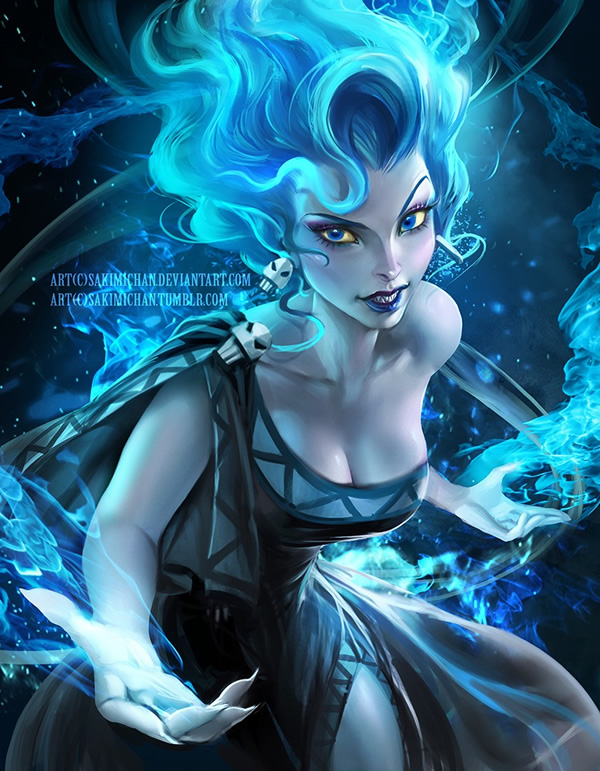
Female Hades (Hercules)

Male Pocahontas
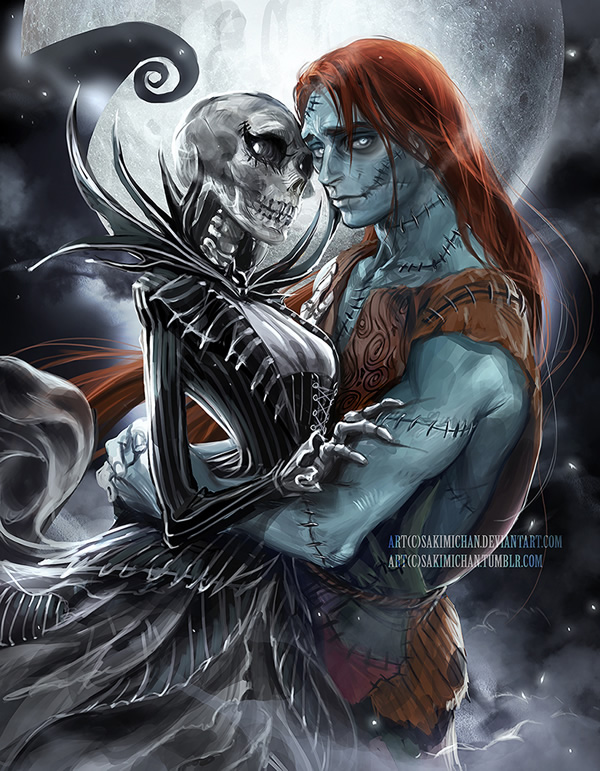
Gender swapped Jack and Sally (The Nightmare Before Christmas)

Male Esmeralda (Hunchback of Notre Dame)

Male Ursula (The Little Mermaid)

Male Maleficent (Sleeping Beauty)
The Origin of the Fork
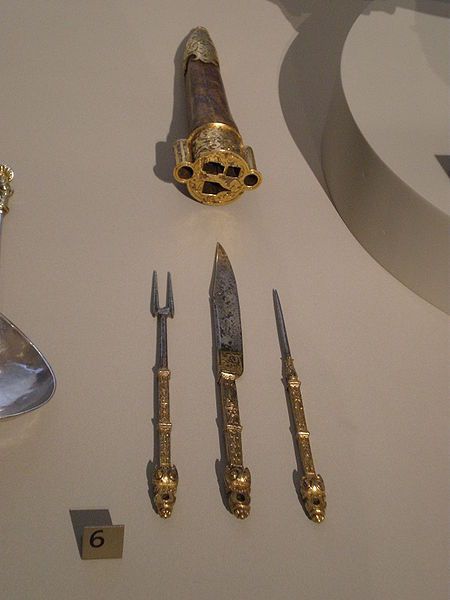 The following is an article from Uncle John’s All-Purpose Extra Strength Bathroom Reader.
The following is an article from Uncle John’s All-Purpose Extra Strength Bathroom Reader.
Of the three eating utensils we normally use, only forks have a modern origin. Knives and spoons are prehistoric- but as recently as 1800, forks weren’t commonly used in America. Some food for thought…
KNIVES, BUT NO FORKS
Centuries ago, few people had ever heard of a “place setting.” When a large piece of meat was set on the table (sometimes on a platter, sometimes directly on the table), diners grabbed the whole thing with their free hand… then pulled out a knife and sliced off a piece with their other hand. Most eating was done with fingers: Common people ate with all five, while nobles -who understood sophisticated table manners- ate with only three (thumb, forefinger, and middle).
At that time, there were no utensils. In fact, most men owned just one multipurpose blade, which, in addition to carving food, was used for fighting, hunting, and butchering animals. But wealthy nobles had always been able to afford a different knife for each purpose, and by the Middle Ages, they had developed a setting of two knives, for very formal dining. One knife was thrust into a large piece of meat to hold it in place on a plate, while the second was used to cut off a smaller piece, which the eater speared and placed in is mouth.

FORKS
One of the drawbacks of cutting a piece of meat while holding it in place with a knife is that the meat has a tendency to “rotate in place like a wheel on an axle,” Henry Petroski writes in The Evolution of Useful Things. “Frustration with knives, especially in their shortcoming in holding meat steady for cutting, eventually led to the development of the fork.” The name comes from furca, the Latin word for a farmer’s pitchfork.
The first fork commonly used in Europe was a miniature version of the big carving fork used to spear turkeys and roasts in the kitchen. It had only two “tines” or prongs, spaced far enough apart to hold meat in place while cutting it; but apparently it wasn’t something you stuck in your mouth and ate with -that was still the knife’s job.
A FOOLISH UTENSIL
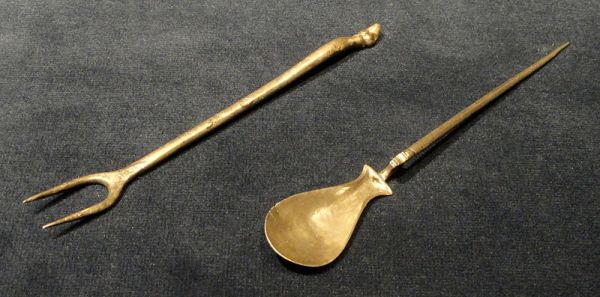 Byzantine Fork and Spoon
Byzantine Fork and Spoon
Those first table forks probably originated at the royal courts of the Middle East, where they were in use as early as the seventh century. About 1100 AD they appeared in the Tuscany region of Italy, but they were considered “shocking novelties,” and were ridiculed and condemned by clergy, who insisted that “only human fingers, created by God, were worthy to touch God’s bounty.” Forks were “effeminate pieces of finery,” as one historian puts it, used by sinners and sissies but not by decent, God-fearing folk.
“An Italian historian recorded a dinner at which a Venetian noblewoman used a fork of her own design,” Charles Panati write in The Extraordinary Origins of Ordinary Things, “and incurred the rebuke of several clerics present for her ‘excessive sign of refinement.’ The woman died days after the meal, supposedly from the plague, but clergymen preached that her death was divine punishment, a warning to others contemplating the affectation of a fork.”
FORK YOU
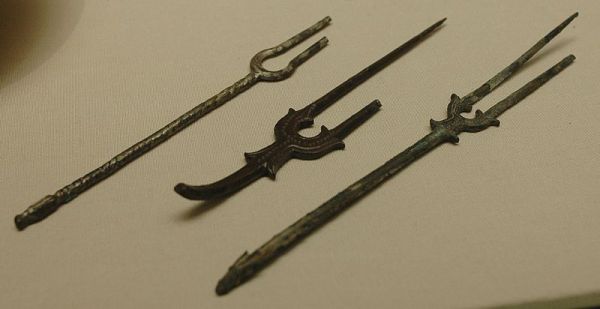 Early French Forks
Early French Forks
Thanks to these derogatory associations, more than 250 years passed before forks finally came into wide use in Italy. In the rest of Europe they were virtually unheard of. Catherine de Medici finally brought them to France in the 1500s when she became queen. And in 1608 an Englishman named Thomas Coryate traveled to Italy and saw people eating with forks; the sight was so peculiar that he made note of it in his book Crudities Hastily Gobbled Up in Five Months:
The Italians… do always at their meals use a little fork when they cut their meat… Should [anyone] unadvisedly touch the dish of meat with his fingers from which all at the table do cut, he will give occasion of offense unto the company, as having transgressed the laws of good manners, insomuch that for his error he shall be at least browbeaten if not reprehended in words… The Italian cannot by any means indure to have his dish touched with fingers, seeing all men’s fingers are not alike clean.
Coryate brought some forks with him to England and presented one to Queen Elizabeth, who was so thrilled by the utensil that she had additional ones made from gold, coral, and crystal. But they remained little more than a pretentious fad of the royal court.
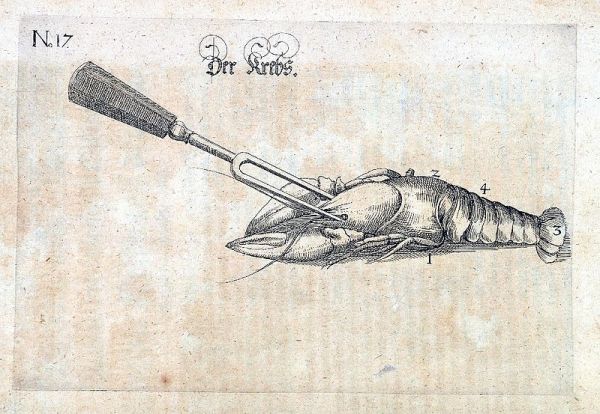 Fork Use 1624
Fork Use 1624
Forks became more popular during the late 17th century, but it wasn’t until the 18th century that they were widely used in continental Europe as a means of conveying food “from plate to mouth.” The reason: French nobles saw forks as a way to distinguish themselves from commoners. “The fork became a symbol of luxury, refinement, and status,” writes Charles Panati. “Suddenly, to touch food with even three bare fingers was gauche.” A new custom developed- when an invitation to dinner was received, a servant frequently was sent ahead with a fine leather case containing a knife, fork, and spoon to be used at dinner later.
MAKING A NEW POINT
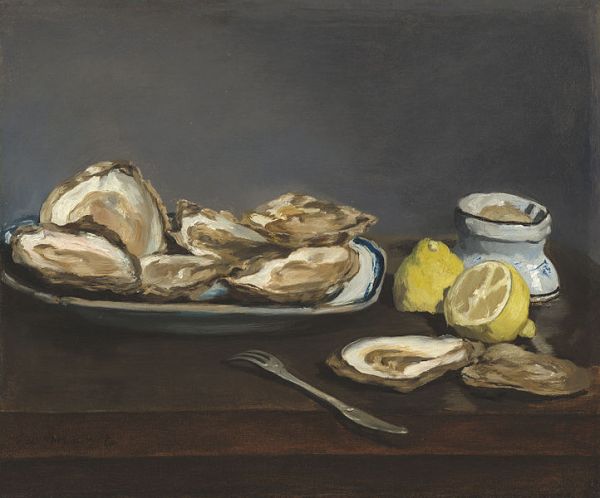
Édouard Manet's Oysters 1862
But before this revolution took place, the fork had to be redesigned. The first forks were completely useless when it came to scooping peas and other loose food into the mouth- the gap between the tines was too large. So cutlery makers began adding a third tine to their forks, and by the early 18th century, a fourth. “Four appears to have been the optimum [number],” Henry Petroski writes in The Evolution of Useful Things. “Four tines provide a relatively broad surface and yet do not feel too wide for the mouth. Nor does a four-tined fork have so many tines that it resembles a comb, or function like one when being pressed into a piece of meat.”
COMING TO AMERICA
One of the last places the fork caught on in the Western world was colonial America. In fact, forks weren’t even commonly used until the time of the Civil War; until then, people just ate with knives or their fingers. In 1828, for example, the English writer Francis Trollope wrote of some general, colonels, and majors aboard a Mississippi steamboat who had “the rightful manner of feeding with their knives, tip the whole blade seemed the enter the mouth.” And as late as 1864, one etiquette manual complained that “many persons hold forks awkwardly, as if not accustomed to them.”
(Title image credit: David Jackson)
_______________________________
 The article above is reprinted with permission from Uncle John's All-Purpose Extra Strength Bathroom Reader.
The article above is reprinted with permission from Uncle John's All-Purpose Extra Strength Bathroom Reader.
The 13th book in the series by the Bathroom Reader's Institute has 504 pages crammed with fun facts, including articles on the biggest movie bombs ever, the origin and unintended use of I.Q. test, and more.
Since 1988, the Bathroom Reader Institute had published a series of popular books containing irresistible bits of trivia and obscure yet fascinating facts. If you like Neatorama, you'll love the Bathroom Reader Institute's books - go ahead and check 'em out! 
Así mató Hollywood al autoestopista galáctico
Pocas novelas han empezado con una lección de perspectiva mejor, y muy pocas con una a semejante escala.
A un pobre mindundi inglés, Arthur Dent, se le plantan las excavadoras en casa una buena mañana para derribarla y construir una vía de circunvalación. Como toda explicación recibe la de que los planos del proyecto llevan meses expuestos en la oficina de planificación local, en el sótano del ayuntamiento.
El problema es terrible pero nada que no resuelva la solución universal a cualquier problema, que es un problema peor. En este caso, una flota de naves alienígenas que aparece en la atmósfera unos minutos más tarde avisando de que la Tierra va a ser demolida para construir una ruta de circunvalación espacial. Como única explicación aportan la de que los planos del proyecto llevan cincuenta años expuestos en el departamento de planificación local, en el sistema Alfa Centauro.
Por suerte, el mejor amigo de Arthur, Ford, resulta ser un alienígena natural del sistema Betelgeuse que consigue improvisar una manera de escapar de la Tierra justo antes de su destrucción. La imagen que sigue y el título de la novela de la que hablamos, la Guía del autoestopista galáctico, dan una idea de cómo.
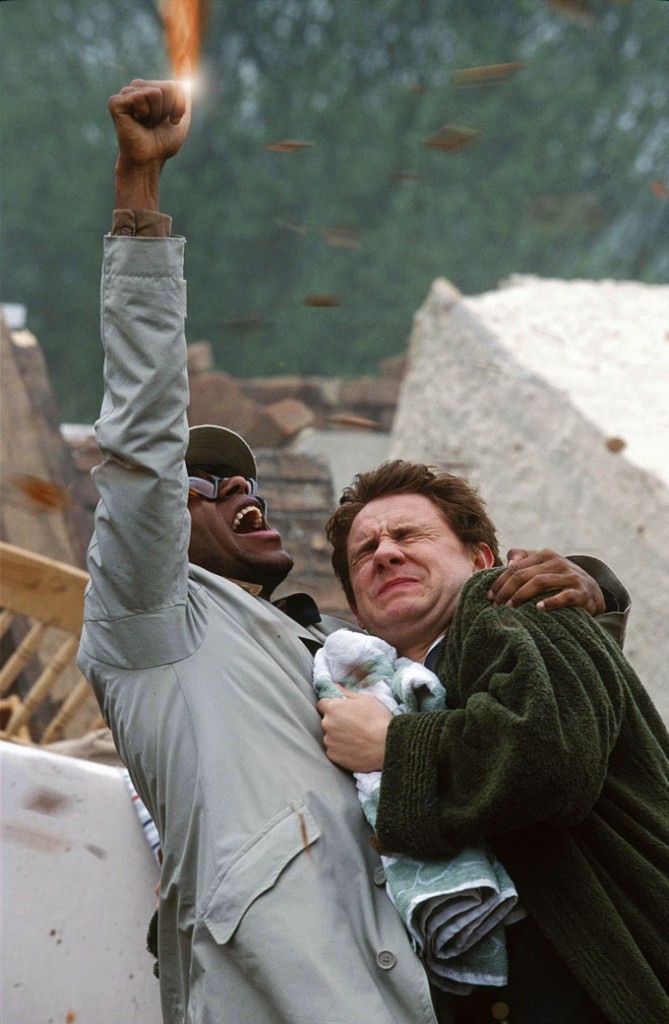
Imagen: Touchstone Pictures / Spyglass Entertainment.
Y la película contaba con este mismo arranque espectacular, pero no solo con eso. También tenía un tráiler digno de pasar a la historia misma de los tráileres, un tema musical magnífico y al mejor protagonista del mundo cuando la cosa va de ser inglés en sitios que no son Inglaterra, que es Martin Freeman. Mos Def hizo un Ford Prefect digno de su apellido —es decir, casi perfecto— y lo de Sam Rockwell como Zaphod Beeblebrox fue ya para ponerse a tirar cohetes. Además, la película de la Guía incorporaba el mejor reparto de voces que se puede reunir en este brazo de la galaxia, con Alan Rickman, Stephen Fry, Helen Mirren, Richard Griffiths e Ian McNeice, y secundarios del grado de John Malkovich y Bill Nighy. Tenía dinero —casi cincuenta millones de dólares, todos los necesarios y alguno más—, el diseño artístico materializaba con precisión las imágenes que evoca el libro en la cabeza del lector —esto no es cualquier cosa— e incluso Gareth Jennings, su director, acertó en esa aleación tan complicada que es la del digital con el látex, sabiendo dónde parar con lo primero y en donde queda más resultón lo segundo. Incluso el momento de su estreno era el ideal, porque en 2005 arrancaba la edad de oro de las franquicias y el gran rebrote cinematográfico de la ciencia ficción, dos ejes en cuya intersección acababan de dar el petardazo títulos como Austin Powers y Men in black. Y para mayor carambola, la cinta tenía un guión coescrito por el mismísimo autor del libro, Douglas Adams, que había muerto antes del rodaje a la edad temprana y triste de cuarenta y nueve años. Y todos sabemos lo bien que funcionan esas cosas en la taquilla.
Pero no. La película no solo no se constituyó en el arranque de la gran saga que estaba llamada a inaugurar —la Guía del autoestopista galáctico es solo el primer volumen de lo que su autor denominó «una trilogía en cinco partes»—, sino que pasó discretamente por las salas de cine y cerró, en general, con aires de gran bluf. En taquilla recaudó el doble de lo que había costado —el estándar de las majors para considerarlo ni un éxito ni un fracaso— y los críticos coincidieron en sus dardos, señal de que llevaban razón: la película brillaba por momentos pero renqueaba en la continuidad. En la web Rotten Tomatoes tiene hoy un sesenta por ciento de críticas positivas y en Filmaffinity una puntuación de 6,1, otra coincidencia que habla con elocuencia de su mediocridad. Ni pena ni gloria, para entendernos, pero a partir de un libro que es la gloria. Es decir, que más bien pena.
¿Qué pasó? En sentido amplio está claro, en particular porque hablamos de una producción con secuencias tan brillantes como esta, esta o esta otra. Pasó que las cosas con frecuencia son algo más que la suma de sus partes y que la Guía del autoestopista galáctico no consiguió sumar. Para descartar otro veredicto tan recurrente y abstracto como este mismo, recordemos que también se ha dicho mucho que la Guía y sus continuaciones son libros inadaptables, pero eso no es verdad. Existen libros fundamentalmente inadaptables pero no lo son por el antojo de sus admiradores, que cuando la literatura es buena suelen concluir que no se puede adaptar. Cuando un libro no se puede trasvasar al cine es por la consustancia lingüística de su historia, sin la cual pierde el sentido. Es lo que le ocurre al que seguramente es el libro inadaptable más famoso, Cien años de soledad, o al Ensayo sobre la ceguera de Saramago, cuya versión fílmica acabó lógicamente en gran castaña. Y los libros de Adams, empezando por el primero, tienen poco de juego lingüístico y sí mucho de acción visual, precisamente aquello que trasunta mejor en cine. Además sus entregas están estructuradas en la forma misma de una película —acaban en una escena que precede el arranque del siguiente, todo un to be continued— y nacieron en la forma de un serial radiofónico para la BBC, algo verbal pero ya adaptado a las formas de la continuidad propias del cine. No. La Guía se podía adaptar e incluso adaptar muy bien, o de lo contrario no existirían ficciones como Doctor Who (1). Lo que ocurrió es que no se hizo bien.

Imagen: Touchstone Pictures / Spyglass Entertainment.
La propia historia de la adaptación ya empezó mal, de hecho, con una travesía tortuosa por los despachos laberínticos de Hollywood (2) en la que el proyecto murió y resucitó varias veces debido al rechazo sucesivo de los guiones escritos por Adams y después, en 2001, por el propio fallecimiento del escritor (3). ¿Debería extrañar? Debería. La Guía del Autoestopista galáctico había sido un éxito en la radio en 1978 y un superventas editorial después de su lanzamiento en Reino Unido en 1979, cuando se convirtió en el libro más demandado ya en su segunda semana de vida comercial y vendió doscientos cincuenta mil ejemplares en solo tres meses. Normalmente Hollywood no espera veinticinco años para echar mano de estos filones, no digamos ya si son sagas. Y en este caso particular el autor no solo colaboraba, sino que lo deseaba hasta el punto de trasladarse a vivir a Los Ángeles para trabajar en el proyecto, que fue por cierto donde la muerte le sorprendió. Citando a Ed Victor, el agente literario de Adams, «Douglas siempre, siempre quiso que se hiciera una película del libro». La cursiva es suya, no nuestra.
Uno de los coproductores ejecutivos de la cinta, Robbie Stamp, tiene una teoría particularmente optimista sobre lo que pasó, que es que todo fue bien y no pasó absolutamente nada. Una de las ediciones de la novela más populares hoy en España, la de Anagrama de 2007, incluye un epílogo en el que Stamp pormenoriza el desencallamiento del proyecto, que fundamentalmente exigió que Adams muriese para que un guionista a sueldo de los productores le diese, y citamos, un «enfoque» nuevo al guión escrito por el autor de la novela y una «dirección fundamental» a la película. El elegido para hacerlo fue Karey Kirkpatrick, que tenía pocos avales en su haber —los guiones solamente de James y el melocotón gigante y Chicken Run: Evasión en la granja— pero de quien Stamp resalta varias virtudes, entre ellas «su buen oído para el humor inglés» y que, pese a eso, «comprende perfectamente que en Hollywood se necesita una férrea estructura». También se cuida de aclarar que, andamios aparte, todas las «nuevas ideas» que separaban al guión de la novela procedían del texto cinematográfico del propio Adams, así como que contaba con el visto bueno de su viuda y la bendición legal, pues los derechos ya estaban adquiridos. Sobre el hecho de que el escritor no permitiese en vida que nadie tocara sus guiones, en cambio, solo pasa de puntillas.
Muerte y venganza de Tricia McMillan
Stamp tampoco explica el sentido de las transformaciones del material original, a las que dedica solo los eufemismos acostumbrados en estos casos, particularmente términos como los citados «enfoque», «estructura» y «dirección fundamental». Cualquiera que haya leído la novela y haya visto la película, sin embargo, sabe que la gran víctima de los cambios, y a la postre su gran causa, fue el personaje de Tricia McMillan.
En la historia original, la única superviviente humana además de Arthur es matemática y astrofísica y abandonó la Tierra unos meses antes de su destrucción acompañando a Zaphod Beeblebrox, un ligue que se echó en una fiesta de disfraces que resultó ser extraterrestre, bicéfalo y presidente electo de la galaxia. Cuando la novela arranca, ambos huyen de la policía galáctica después de secuestrar el Corazón de Oro, una fabulosa nave espacial que funciona con energía de improbabilidad infinita. La fuente de propulsión tiene efectos secundarios, sin embargo, y en efecto hace que ocurra lo más improbable: que se acaben cruzando en el camino de Ford —que es primo de Zaphod— y de Arthur —que también intentó ligar con Tricia McMillan en aquella fiesta— en la inmensidad del espacio. Ella ahora se llama Trillian, por cierto. El mismo nombre, pero más «space-like».
A la hora de hacer la película, sin embargo, Trillian no convenció a quien debía y alguien, seguramente delante de un Power Point, tuvo la idea de cambiar al personaje y su rol en la historia para que jugase un papel —atención, sorpresa— más femenino. Ahora Trillian sería el vértice de un triángulo amoroso entre ella, Zaphod y Arthur y hasta llegaría a mantener una relación romántica con el protagonista, algo que en modo alguno ocurre en los cinco libros originales de la Guía o en los seriales radiofónicos. Para ello se la desproveyó de buena parte de sus gags y se confeccionó una subtrama nueva en la que la chica —atención, más sorpresas— resultaba secuestrada y en la que los hombres —festival de las sorpresas— tenían que rescatarla de las garras de los malos. En conjunto, los personajes dejaron de ser un cuarteto dividido en dos pares —Arthur y Ford, Zaphod y Trillian— para convertirse en un trío de carismas —Arthur, Ford y Zaphod— al que se suma un personaje femenino que juega el papel, en efecto, de personaje femenino. La repetición significa que lo decimos con retintín.

Prueba de agudeza visual. ¿Cuál de estas dos escenas resulta más redonda, más acabada, más cinematográfica? Pues eso. Imagen: Touchstone Pictures / Spyglass Entertainment.
Fueron los cambios operados en este sentido los que arruinaron sin remedio el guión de la Guía del autoestopista galáctico. Pensemos, por ejemplo, en el poderoso paralelismo con el que arranca la Guía, aquel entre la demolición de la casa de Arthur y la destrucción de la Tierra. En la película desaparece, neutralizado por un flashback insertado con calzador entre uno y otro hecho para meternos por los ojos a Trillian y arruinar, por cierto, la sorpresa de que ella y Arthur se conocieran, que Adams reservó para un punto avanzado del libro. Pensemos en la trama que arranca a partir de ahí, que originalmente embarcaba a los protagonistas en una aventura que les llevará a conocer la verdadera naturaleza del planeta Tierra —que se dice pronto— y pensemos en cómo en la película el viaje se ve interrumpido para que Trillian resulte raptada, rescatada y después poder continuar. Pensemos en el ordenador Pensamiento Profundo y en su célebre respuesta a la pregunta sobre el «sentido de la vida, el universo y todo lo demás» (4), en el cachalote y el enigmático tiesto de petunias que se materializan en Magrathea fruto de la improbabilidad y en todos los otros chistes deliciosamente existencialistas y sui generis de la Guía. Originalmente marcaban el rumbo fundamental de la trama, pero en la película solo recibe continuidad la historia de amor que Adams nunca escribió y lo demás —la verdadera comedia de ciencia ficción— ha sido picado para que le sirva como aderezo. Incluso las novedades más anecdóticas del guión respecto a la novela lo son al servicio del romance hueco y convencional del protagonista y su chica, entre ellas el arma del punto de vista. Fue una idea original de Adams, sin duda ocurrente y graciosa, pero en el texto que se rodó sirve solo para que Trillian la acabe empuñando contra Zaphod y se dé así cuenta de que a quien ama realmente es a Arthur. Y hasta llora con el descubrimiento, no te lo pierdas. Llora, sí. De pena y de tristeza. En la Guía del autoestopista galáctico.
Es a esto, en resumen, a lo que se refirieron los críticos cuando dijeron que la película carece de continuidad, un diagnóstico que no es preciso. Hay continuidad pero no donde debe haberla, en la comedia y la ciencia ficción, sino en aquello que atrae más visitantes a las salas de cine, que es el romance. Y eso es injusto con el espíritu que le imprimió a su obra el autor, aunque vendidos los derechos la justicia y la injusticia son lo de menos. Lo verdaderamente determinante, y por eso le estamos dedicando este rato al asunto, es que es el resultado es peor.
Guía del sexismo galáctico
Nos queda una tercera cabeza por reclamar después de la de Stamp y Kirkpatrick, pero no es la de Zooey Deschanel. Resulta tentador aducir lo aburrida de su Trillian a la poca vis cómica de la actriz, que en efecto tiene poca, pero no se le puede pedir más. Mutilaron su texto de chistes y le metieron escenas tan penosamente convencionales como la de tener que darse una ducha mientras su apocado aspirante a novio se ruboriza cuando le alcanza la toalla. No se rompieron la cabeza, como ven. El personaje definitivo no daba más de sí.

Imagen: Touchstone Pictures / Spyglass Entertainment.
El propio Robbie Stamp nos sirve la última de las cabezas en bandeja de plata cuando entrevista precisamente a Deschanel en el epílogo de la edición de Anagrama de la Guía, comentando «por qué se acabó dando luz verde a la película». Dice Stamp que «se debió a varias razones», pero que la principal «por la que Nina Jacobson dio su aprobación fue porque habíamos trabajado muy duro para crear una relación sólida entre Trillian y Arthur». Y Zooey Deschanel, por cierto, responde que sí, que tal «constituye la principal diferencia entre la Guía en sus otras versiones y la película» y añade que cree que «va a funcionar muy bien en la pantalla». Pobrecita mía.
Nina Jacobson, ya lo han oído. La todopoderosa ejecutiva de Disney. Entonces era la responsable de proyectos de la casa y quien timoneó la adaptación de la Guía desde uno de sus grandes brazos comerciales, Touchstone Pictures. Fue ella quien puso los millones solamente cuando hubo un guión en el que Trillian le daba una réplica romántica sólida al protagonista, arguyendo que la cinta «tenía que estar arraigada en la visión del mundo de Douglas, pero para que interesara a Disney tenía que llegar a un público nuevo». Y con «público nuevo» no se refería a un público nuevo, por supuesto, sino a un público mayor. Es a lo que se refieren con frecuencia quienes atribuyen eufemismos grandilocuentes a la audiencia, el lector, el espectador y ese tipo de figuras. Y los eufemismos, como todos sabemos, suelen referirse a algo peor.
Las razones de Nina Jacobson para cambiar la Guía fueron por supuesto comerciales —aquí el eufemismo sería «cinematográficas», pero fueron comerciales—, aunque incurriendo por el camino en un ejercicio evidente de sexismo. Habrá a quien le extrañe viniendo precisamente de ella —lesbiana, activista y distinguida con varios reconocimientos relacionados con la igualdad de sexos, entre ellos un Crystal Award y una posición envidiable en la lista Forbes de las mujeres más poderosas del mundo—, pero también habrá a quien no. M. Night Shyamalan es uno de ellos. Nina Jacobson le produjo en su día El sexto sentido pero la prolongada relación entre ambos acabó en pajarraca a raíz del guión de La joven del agua, que Shyamalan agarró junto al resto de sus bártulos y acabó llevándose a Warner Bros. Entre las críticas feroces que le dedicó a la ejecutiva por su injerencia están la de que «no quiere directores iconoclastas» y que solo le interesan cineastas «que hacen dinero». Robbie Stamp, sin embargo, solo sabe alabar los cambios que Jacobson imprimió a la Guía y se acuerda de recordar que Nina afirmó en cierta reunión que «si iban a hacer la película, debían hacerla bien» y que «no iba a pasar a la historia como la ejecutiva que se cargó la Guía». Con «bien» se refiere a los cincuenta millones de dólares que puso sobre la mesa, toda una fortuna. Con «no pasar a la historia como la ejecutiva que se cargó la Guía» se refiere exactamente a lo contrario de lo que ocurrió.
Decíamos al empezar que pocas historias han comenzado con una lección de perspectiva mejor que la que imparte la Guía y lamentábamos después que la película no contara con ella. En esa misma carencia, sin embargo, yace otra lección más sutil sobre la relatividad de las cosas, una que habla precisamente de su universalidad. Todos los que dijeron que el guión cinematográfico de la Guía debía ser así, y no de otra forma, se equivocaron. Arguyeron razones deterministas, como hacen con lamentable frecuencia los profesionales de la ficción, y a los verdaderos motivos de la transformación le dedicaron eufemismos para enmascarar su objetivo real: hacer dinero. Hacer más dinero, concretamente, que el dinero que habría hecho una buena versión cinematográfica, que podría ser mucho pero no tanto como el que querían. Aprovecharon la muerte de quien se lo impedía, que era su autor, y prefirieron una Guía diluida a conciencia para saberle mejor a ese paladar colectivo que Disney, en este caso, ha invertido tanto tiempo y recursos en educar. Tanto lo hicieron que la cagaron, como ilustra aquella historia tan vieja de una gallina que ponía huevos de oro, aunque en este caso quizá sea por ventura de la propia gallina. A fin de cuentas, podemos seguir diciendo que la Guía del autoestopista galáctico carece de una gran versión cinematográfica como la que tanto deseó Douglas Adams. Ahora solo falta que se anime otro, que no tarde otros veinticinco años y que guarde una proporción más sana entre sus ambiciones artísticas y las comerciales. Todo lo demás está escrito, de verdad, sin necesidad de hacerle demasiados cambios. Todo eso y otros cuatro libros más (5).

Imagen: Touchstone Pictures / Spyglass Entertainment.
(1) Esto no es una forma de hablar. Douglas Adams, de hecho, fue guionista de Doctor Who.
(2) Sobre esto Adams dejó una afirmación famosa, la de que levantar un proyecto en Hollywood es como «intentar cocinar un filete a la plancha mediante el sistema de hacer entrar una serie de gente en la cocina y echarle el aliento».
(3) Aunque se rechazaron varios guiones, el primer escollo que encontró la adaptación fue la situación de los derechos de la obra, en particular en lo concerniente al merchandising. Antes que una película, la Guía del autoestopista galáctico había sido un serial radiofónico de BBC en 1978, una novela de Pan Books de 1979, una serie televisiva de BBC en 1981 y un videojuego de Infocom en 1984. También se había adaptado al teatro, como software y en multitud de títulos literarios comentados, ilustrados y de cómic.
(4) Que no revelaremos aquí, o estaríamos incurriendo seguramente en el spoiler más espectacular de todos los tiempos.
(5) Cinco libros, de hecho. En 2009, Penguin Books publicó una sexta entrega de la Guía del autoestopista galáctico que le encargó a Eoin Colfer con la autorización de la viuda de Adams, Jane Belson. Es un libro espantoso del que quizá hablemos algún día en otro artículo, aunque si lo ven no hace falta que lo lean. Será una crítica muy parecida a la que hacemos en este.
Artículos relacionados
-
 ¿Es «La historia interminable» la peor adaptación cinematográfica de la historia?
¿Es «La historia interminable» la peor adaptación cinematográfica de la historia?
-
 Ciencia Ficción: los orígenes (I)
Ciencia Ficción: los orígenes (I)
-
 Star Wars (I): A la vejez, precuelas
Star Wars (I): A la vejez, precuelas
-
 Defensa en cinco puntos de The Matrix Reloaded
Defensa en cinco puntos de The Matrix Reloaded
-
 Una educación inglesa
Una educación inglesa
-
 Surcando las estrellas: las 15 naves espaciales más interesantes de la cultura
Surcando las estrellas: las 15 naves espaciales más interesantes de la cultura
Wheat Isn’t the Reason Why You Can’t Stop Farting
How To Get Fucked Like An Artist
As a creative millennial, there’s nothing I enjoy more than thinking nothing and fucking everything. There’s nothing I enjoy more than expanding my pussy in tandem with my horizons. I like to find myself in other people, by putting them into my body and calling it experience.
I want to get fucked like an artist. I want to have my vag dogged down by the biggest cock I can find. I want to be blown out like the candles at the holocaust museum. I want to be stretched to my limits like a sweaty, diabetic sock around an edematous foot. I want my pussy to hang loose and bloody, like a parachute that deployed wrong and sucked it’s wearer through a jet engine. I want it to pop like an overfilled water balloon. I want it to pop like someone smacked a tube of Pillsbury Grands against a counter top.
I want to be folded over like a playing card table at the end of boys’ night – covered in beer and spit and cigarette burns. I want my pussy to be cursed at, and used as a sounding wall to vent about failed marriages. I want to be casually abused and put away in the work shed. I want to get fucked so someone doesn’t beat their kids. I want to get fucked so someone can keep their job.
I want to get fucked so hard my perineum tears. I want it sewn back up, and then I want to get fucked so hard that I hear the stitches pop like shower curtain rings as I collapse in the tub.
I want my pussy walls to shred like a semi tread and fly out of my body at sixty miles per hour. I want it to smash through the window of a minivan and decapitate a mother and her kids. I want my pussy on the local news. I want there to be outrage. I want there to be mourning. I want little white crosses on the side of the road so that every time I drive by, I can remind myself that I got fucked so hard I killed a family.
I want to fill my pussy with bees. I want a thousand stingers pressed into my walls at the same time. I want to go into anaphylactic shock, and slip into a coma. I want the bees to set up camp in my swollen pussy. I want them to fill it with wax and cause alarm when some neighborhood kids are hospitalized after playing too close to it. I want the parents to petition city hall to do something about my problematic pussy. I want city hall to hire an exterminator. I want the exterminator to gas my pussy, and scoop out all the dead bees and honey. I want them to seal it off, and hide it from future children and future bees. I want stories of my bee pussy to become apocryphal legend. I want my pussy to be summer camp lore. Something the kids speak of before lights out, to scare each other.
I want an STD. I want all of the STDs. I want one of those sex-education-cautionary-example disaster pussies. I want my pussy to look like a haggard, variegated mess of spots and fur. I want my pussy to look like all 101 Dalmatians beaten to death at once. I want Cruella De Vil to inquire about my pussy, ask how it’s coming along, and eventually conspire to kidnap my pussy so she may wear it as a coat.
I want my STD pussy to look like a big bowl of Pho, muddled with too much Sriracha and hoisin sauce, over flavored and contaminated. I want to show it off to my white friends and tell them they’re pronouncing it wrong. I want to spill it all over the table and tip poorly. I want to take what’s left of my pussy to go, forget it at the back of the fridge, and let it rot next to the vegetables that I buy but don’t eat.
I want to get fucked so hard that my uterus prolapses, pokes its head out of my crotch like Porky Pig, and tells folks that’s all.
I want to define myself with my pussy, eschew meaningful experience, practice yoga, and fold myself into my pussy. I want to live in there, among my decisions and my rationalizations, complimenting myself for my creativity while wasting my life. I want to get fucked like an artist. 
Talan un carballo de 300 anos no Camiño de Santiago por unha poda dunha compañía eléctrica
Tacocat – NVM (2014)
SnobA miña banda feminista favorita. :3
 Is misandry a growing threat to our society? Catcalling women on the street: a socially acceptable form of flattery? Do you have an allergy to certain delicious herbal tea blends? If you said yes to any of these questions, the members of Tacocat are not your friends, but you might end up liking them anyway. Though they’ve been around since 2007, the Seattle quartet are relatively new to a wider audience. Over the past few months, they’ve been expanding upon their longtime underground reputation as a gutsy bubblegum surf-rock outfit bolstered by an adorable meme, some goofy Y2K nostalgia, and—above all—an unparalleled feminist wit that’s hard to hate, even if you’re the target.
Is misandry a growing threat to our society? Catcalling women on the street: a socially acceptable form of flattery? Do you have an allergy to certain delicious herbal tea blends? If you said yes to any of these questions, the members of Tacocat are not your friends, but you might end up liking them anyway. Though they’ve been around since 2007, the Seattle quartet are relatively new to a wider audience. Over the past few months, they’ve been expanding upon their longtime underground reputation as a gutsy bubblegum surf-rock outfit bolstered by an adorable meme, some goofy Y2K nostalgia, and—above all—an unparalleled feminist wit that’s hard to hate, even if you’re the target.
It’s born of practice: Tacocat’s debut record,…
320 kbps | 67 MB | UL | OB | MC ** FLAC
…the ironically sunshiny NVM, is hardly their first foray into the satire game. Back in 2012, vocalist Emily Nokes and bassist Bree McKenna were the pair of masterminds behind “Men Who Rock,” the now-legendary cover feature of local Seattle weekly The Stranger that brilliantly skewered the music media’s objectification of female musicians. Two years later, NVM—an abbreviation for “nevermind” coined by the post-Nirvana AOL generation—has become an extension of that tradition, turning just the right cheerful screws on haters from all corners of their hegemonic hellscape.
Whether it’s the male gaze (“Hey Girl”) or menstruation (“Crimson Wave”), seasonal affective disorder (“Bridge to Hawaii”) or becoming a woman (“Psychedelic Quinceañera”), or even just hometowns that have a collective aneurysm every time it snows (“Snow Day”)—no vexation is safe from the sprightly melodies of Tacocat. “In my experience, making jokes about that kind of stupid stuff has made people check themselves more than when people yell at them about it,” Nokes said in a recent interview. So instead of a blistering indictment, she and her friends made an album that throws a double-handful of confetti in the face of topics that might otherwise induce rage blackouts, a light-hearted reminder that sometimes the best way to defeat an enemy is to make them sheepishly laugh.
Like many of their compatriots, Tacocat draw as heavily on 60s surf rock and girl-group radio hits as they do on 90s and 00s MTV alt-rock rotation (“Quinceañera” is bolstered by horns worthy only of Cake), but where peers have settled for simple, fest-ready party rock, Tacocat use those influences to complement a musical comedy that’s effortless and immediately justifies its existence: I didn’t realize I needed a song about hating my bus line with an all-consuming passion, yet “FU #8″ delivers like a Sky Mall patent direct from heaven. Almost every track, save the disappointing-only-by-comparison “Alien Girl” and opener “You Never Came Back”, serves a highly specific, completely unromantic purpose, especially in the lives of women: they’re simple theme songs, #realtalk jingles to tuck away in the personal artillery that gets you through a particularly dumb day.
And though it seems downright insane when paired with the actual sounds contained on the album, most of NVM, despite its humor, is still sincerely concerned with the bullshit inherent in power structures, as much as a Bikini Kill or a Sleater-Kinney or even a White Lung. It lacks the sonic weight that so easily matches those feminist frustrations, but it would be foolish to want such things of a band like Tacocat, because there are so few places in which to find sentiments like these in such a refreshingly sunny musical context. The only anchor the album really needs is the certainty that one day your world will treat you like utter garbage, and only the sarcastic irreverence of Tacocat can lift you out of your vortex of suckitude. Cheeky but not bratty, NVM leaves a statement behind without preaching or scolding (save perhaps on “This Is Anarchy,” a satirical, natural mate to millennial eye-rollers like Bent Shapes’ “Brat Poison”). It’s simple and approachable, but its wit gives it longevity—at least, until a song about “communists in the summer house” is passé.
Faith Healer – Try ;-) (2017)
SnobGustame moito.
 Try ;-) is the first album as a duo for Faith Healer, and that means some changes. The first record, Cosmic Troubles, was helmed by Jessica Jalbert with help from producer Renny Wilson. They hit it off so well while crafting that somewhat sleepy and restrained neo-psych-pop album that Wilson joined the band and began to help with writing the songs. His presence from the start of the process seems to have given the band a shove into classic rock territory. Or maybe they just listened to a bunch of their parents’ old LPs. There is still plenty of sticky psych and dreamy psych-folk in the mix, but there’s also a newfound sense of urgency to the playing, lots of guitar solos, sharper hooks, and a much heavier feel to the music. At the same time, they dip their toes into soft rock…
Try ;-) is the first album as a duo for Faith Healer, and that means some changes. The first record, Cosmic Troubles, was helmed by Jessica Jalbert with help from producer Renny Wilson. They hit it off so well while crafting that somewhat sleepy and restrained neo-psych-pop album that Wilson joined the band and began to help with writing the songs. His presence from the start of the process seems to have given the band a shove into classic rock territory. Or maybe they just listened to a bunch of their parents’ old LPs. There is still plenty of sticky psych and dreamy psych-folk in the mix, but there’s also a newfound sense of urgency to the playing, lots of guitar solos, sharper hooks, and a much heavier feel to the music. At the same time, they dip their toes into soft rock…
…smoothness (“& Waiting”), lo-fi synth pop (“Sterling Silver”), and some outer space country-rock that would make Beachwood Sparks blanch on the title track. Jalbert’s vocals haven’t changed much; she’s still icy and aloof in the best way, and the core of the band is much the same. A few songs would have blended in fine on the first record, like the drifting “Such a Gemini” and the echoing ballad “Best Saved 4 Last.” That being said, it’s hard to imagine strutting boogie rockers like “Might as Well” and “2nd Time” finding a home there. The cool thing is that they totally work here, though. In fact, all the additions the duo append onto their original sound only serve to make them sound richer and more interesting.
While the first album definitely held great promise, at times it felt a little half-formed or generic. No worries about that on Try ;-); Jalbert and Wilson are in firm control and it’s an absolute joy to hear them explore new sounds, combine things that should never fit together but somehow do, and deliver a completely satisfying album.













